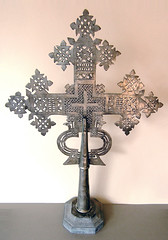Today is St. Patrick’s Day and I wanted to put a Celtic item on the blog, but instead I put on a Coptic cross. The shamrock is a classic triple Christian reference and this also leads me into the triple cross. Although not authentic to Dark Ages Ireland, this Coptic cross is still a pretty good piece and the Copts are very early Christians. It’s a huge processional cross, over 25 inches tall and designed to set up on a six-foot plus staff. This is the biggest Coptic processional cross I have seen outside of a museum. It is presently sitting on a base rather than on a staff, but it’s still pretty impressive. It would make a great prop for an Indiana Jones character and the Etypian/Ethopian association would be good for Call of Cthulhu as well.
The triple cross iconography recalls the Trinity, but the most interesting feature is the Holy Grail depiction, which is figured as a cauldron. When carried in procession, a white sort of scarf is looped through the grail and draped down dramatically. If you recall, Celtic mythology has a lot of references to magic cauldrons, so it is here that I think this might work as a prop for an ancient Celtic staff. The cross springs up from the Holy Grail and the triple symbolism goes on and on. This particular piece probably dates to the 1920s and not much earlier. It is cast in white bronze, although a few early processional crosses appear in silver. I’ve always liked the pierce work in Celtic and Coptic items.
The triple cross iconography recalls the Trinity, but the most interesting feature is the Holy Grail depiction, which is figured as a cauldron. When carried in procession, a white sort of scarf is looped through the grail and draped down dramatically. If you recall, Celtic mythology has a lot of references to magic cauldrons, so it is here that I think this might work as a prop for an ancient Celtic staff. The cross springs up from the Holy Grail and the triple symbolism goes on and on. This particular piece probably dates to the 1920s and not much earlier. It is cast in white bronze, although a few early processional crosses appear in silver. I’ve always liked the pierce work in Celtic and Coptic items.
The Copts insist that they are the inheritors of the Holy Grail and that is hidden in one of their temples. Remember that ancient Alexandria was the seat of magic and learning for hundreds of years, all of that could be worked into a campaign. This is a rich area for research.


No comments:
Post a Comment